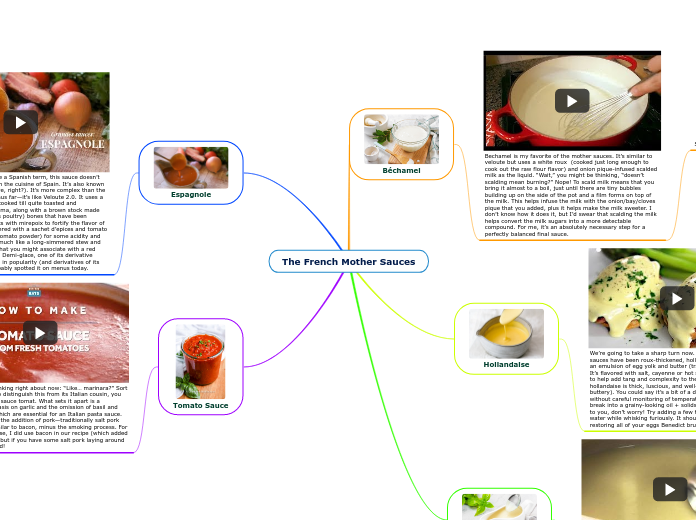What the Characteristics of a good sauce should be
Mother Sauces
To name your story, you have to think about the overall message and what you want your audience to understand from the story. Also, make it relevant and easy to remember.
Roux
1.Melt butter. Add flour and cook to desired color.
2.Add cold liquid a little at a time while whisking until smooth after each addition.
3.Add remaining liquid and seasonings, simmer a couple of minutes.
Mayonnaise
1.Prepare your food processor
2.Add an egg
3.Add mustard, vinegar, and salt
4.Slowly add the oil
Neutral Flavored Oil
Vinegar or lemon juice
Mustard
Egg
Hollandaise
1.Melt the butter in a microwave for about 1 minute until hot.
2.Combine the egg yolks, lemon juice, dijon, salt and cayenne pepper into a high powered blender and blend for 5 seconds.
3.Slowly stream in the hot butter into the mixture as the blender is running.
Egg Yolks
Butter
Salt
Dijon
Lemon Juice
Cayenne Pepper
Tomato Sauce
1. Add Olive Oil and Onions 2. Season 3. Add Garlic 4. Crush Tomatoes 5. Add the Tomatoes and Simmer 6. Add Flavor and Spice
black pepper to taste
tomato paste
fresh tomatoes, peeled, seeded, and chopped
garlic, minced
onion and carrot, finely chopped
olive oil
Espagnole
The ending of a story is essential. We all know that if the ending is weak, what happened before loses its importance. So make it unpredictable, but fair. A resolved ending answers all the questions and ties up any loose threads from the plot.
1. Cook carrot and onion in butter until golden 2. Add flour and cook roux 3. Add hot stock then add tomato purée and sachet d’epices
beef stock
sachet d’epices and tomato puree
mirepoix(carrot and onion)
Bechamel
The middle of the story is where you add layers of complications that will lead to the end. Reveal more about the character's journey. Did their personality go through changes? How did they overcome the challenges? And as you build up the story’s central conflict, make it more personal to that character. Also, from the middle act, you have to lead into the final act.
分支主題
1. Melt the butter 2. Add milk until a film forms on top 3. Add onion/bay/cloves pique
milk
flour
onion/bay/cloves pique
butter
Veloute
In the beginning of the story (or the exposition), you will need to introduce the setting and characters. You might also want to introduce the main conflict. This part of the story is important because it gives the reader necessary background information and maybe even a first insight into a character’s personality.
Video
Recipe
Method
1. Stir the flour into the melted butter to the roux 2. Cooked until lightly toasted and aromatic 3. Gets the stock addition 4. Simmer a little bit
Ingredients
all-purpose flour
clarified butter
white stock(veal, seafood, or chicken)








